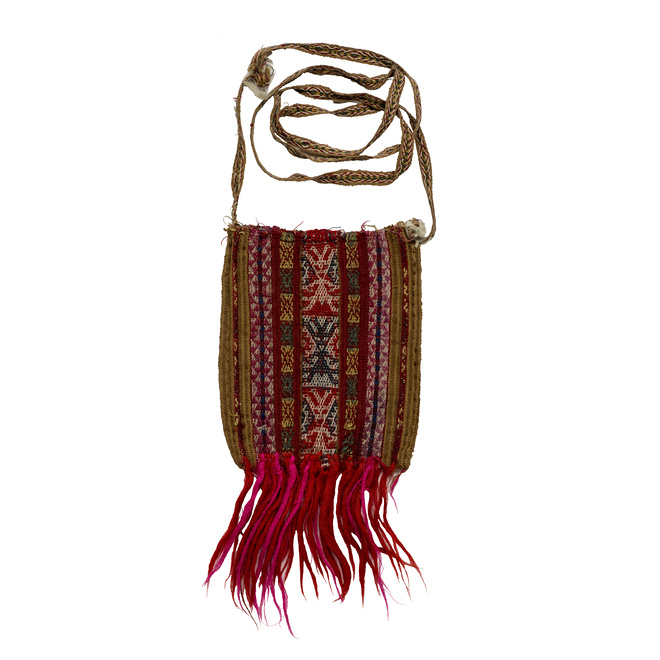
From the Exhibition:
Carrying Coca: 1,500 Years of Andean Chuspas
By the middle of the twentieth century, members of the Q’ero community in the Cusco region of Peru were considered by scholars, including the American Museum of Natural History (AMNH) ethnologist Harry Tschopik Jr., to be almost pure Inca descendants and thus a focus of interest for political figures and museum collectors.1 In 1955 the Peruvian newspaper La Prensa sponsored an expedition to the Q’ero region, and this chuspa was collected as part of a group of thirteen woven bags. One of the primary uses of these bags was to carry coca leaves for chewing, an ancient practice that is still culturally significant today.
This chuspa—or festival bag—is structured in three main parts: a woven strap; a patterned body made of a single woven piece of fabric folded and stitched in the form of a bag; and a fringe made of unspun wool. The body of the chuspa is woven in a three-color complementary warp technique, which means that three different colors of vertical threads, or warps, alternate in order to form the motifs in each patterned stripe of the weaving. The visible threads float over the hidden horizontal threads, or wefts, that hold the structure together. This technique requires careful planning of materials and design from the very beginning of the process, when the loom is warped, or set with the thread that will constitute these motifs.
One of the characteristics that distinguishes this chuspa from the other bags collected on the 1955 expedition is its variety of motifs. Unlike most Q’ero bags, which depict the same motif in three wide stripes, this chuspa has four different motifs distributed in seven stripes. In the center is a jungle dancer, orch’unchu, wearing a feathered headdress, a common pattern in the Cusco region.2 This intriguing figure may have its origins in the trade relationships that the Q’ero maintained with indigenous communities in the jungle, which provided the Q’ero with such products as coca, feathers, and wood for their looms.3 This bond is still represented today in the Qoyllur Rit’i celebration, in which dancers dress as ch’unchus wearing feathered headdresses.
Flanking this central ch’unchu motif are two stripes in a rhomboid form with radiating lines called inti, meaning “sun” in Quechua. Because these four-sided figures are commonly quartered, they have been associated with the suyu system, an Inca scheme for partitioning their territory.4 Under this system the Inca lands were divided into four sections, or suyus, with the Cusco region at the center of the structure. In addition, forty-two conceptual lines, or ceques, spread out from Cusco—just like the lines radiating in the inti motif—to mark the position of at least 328 huacas or shrines.5 Thus, this symbol, with its complex representations of the inti, suyu, and ceque systems, has both physical and cosmological connotations.
Besides the inti, there are two other recognizable motifs in thesechuspas:qocha and chilli. The alternating pink and white triangles featured in the stripes at either side of the inti motifs are calledqocha, meaning “lake.” When the qocha triangles are united to form a diamond, as in some scattered sections inside these same stripes, the pattern is called chilli, meaning “pastures.”6 Lakes are an important component in the ritual practices of the Q’ero, whereas pastures are crucial for the breeding of llamas, alpacas, and vicuñas in the higher lands.
In the last of the patterned stripes—the ones at the outer edges of thechuspa’s body—is a grouping of wefts that appear to form mountain peaks, ork’iraqey puntas. Different versions of this motif traditionally frame other types of Q’ero textiles, such as carrying cloths and ponchos.7 This manifestation is a reminder of the sacred character of mountains for the Q’ero. Nowadays, in the consumption of coca, for example, highlanders still nourish mother earth with offerings of coca leaves, as they attempt to placate the ever-present and unpredictable mountain gods (apu).8
The importance the Q’ero place on the notion of territory is well-reflected in this textile. The symbolic motifs represent trade partners from other regions, modes of compartmentalizing the land, the importance of natural resources, and the ritual character intertwined within these relationships. This chuspa allows us to understand the ways in which the Q’ero live and manage their territory, while infusing that understanding with layers of cultural meaning.
1.Correspondence between Harry Tschopik, Jr. and Myriam Kropp, wife of La Prensa’s director, Pedro Beltrán Espantoso, July 1, 1955. Department of Anthropology Archives, American Museum of Natural History, catalog number 40.0/8880–8921.n.f. ↖
2.Lee Ann Wilson, “Nature Versus Culture: The Image of the Uncivilized Wild-Man in Textiles from the Department of Cuzco, Peru,” in Textile Traditions of Mesoamerica and the Andes: an Anthology, ed. Margot Blum Scheville, Janet Catherine Berlo, and Edward B. Dwyer (New York: Garland Publishing, 1991), 208–10. ↖
3.Oscar Núñez del Prado Castro, et al., Q’ero, el Último Ayllu Inka: homenaje a Oscar Núñez del Prado y a la Expedición Científica de la UNSAAC a la Nación Q’ero en 1955 (Lima: Fondo Editorial de la Facultad de Ciencias Sociales, UNMSM; Cusco: Instituto Nacional de Cultura, Dirección Regional de Cultura de Cusco, 2005), 43. William Harris Isbell and Helaine Silverman, Andean Archaeology III: North and South (New York: Springer 2008), 499. ↖
4.Gail P. Silverman, A Woven Book of Knowledge: Textile Iconography of Cuzco, Peru (Salt Lake City: University of Utah Press, 2008), 59. ↖
5.Brian S. Bauer, “Ritual Pathways of the Inca: An Analysis of the Collasuyu Ceques in Cuzco,” Latin American Antiquity 3, no. 3 (1992): 183–84. ↖
6.Silverman, A Woven Book of Knowledge, 154. ↖
7.Ibid., 67. ↖
8.Nicola Sharratt, Carrying Coca: 1,500 Years of Andean Chuspas (New York: Bard Graduate Center, 2014), 13. ↖
